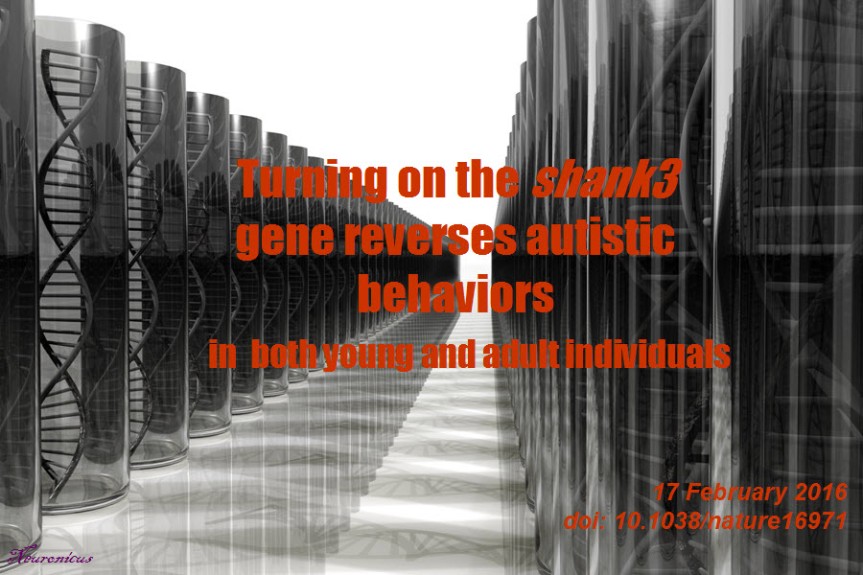
Nothing short of an autism cure is promised by this hot new research paper.
Among many thousands of proteins that a neuron needs to make in order to function properly there is one called SHANK3 made from the gene shank3. (Note the customary writing: by consensus, a gene’s name is written using small caps and italicized, whereas the protein’s name that results from that gene expression is written with caps).
This protein is important for the correct assembly of synapses and previous work has shown that if you delete its gene in mice they show autistic-like behavior. Similarly, some people with autism, but by far not all, have a deletion on Chromosome 22, where the protein’s gene is located.
The straightforward approach would be to restore the protein production into the adult autistic mouse and see what happens. Well, one problem with that is keeping the concentration of the protein at the optimum level, because if the mouse makes too much of it, then the mouse develops ADHD and bipolar.
So the researchers developed a really neat genetic model in which they managed to turn on and off the shank3 gene at will by giving the mouse a drug called tamoxifen (don’t take this drug for autism! Beside the fact that is not going to work because you’re not a genetically engineered mouse with a Cre-dependent genetic switch on your shank3, it is also very toxic and used only in some form of cancers when is believed that the benefits outweigh the horrible side effects).
In young adult mice, the turning on of the gene resulted in normalization of synapses in the striatum, a brain region heavily involved in autistic behaviors. The synapses were comparable to normal synapses in some aspects (from the looks, i.e. postsynaptic density scaffolding, to the works, i.e. electrophysiological properties) and even more so in others (more dendritic spines than normal, meaning more synapses, presumably). This molecular repair has been mirrored by some behavioral rescue: although these mice still had more anxiety and more coordination problems than the control mice, their social aversion and repetitive behaviors disappeared. And the really really cool part of all this is that this reversal of autistic behaviors was done in ADULT mice.
Now, when the researchers turned the gene on in 20 days old mice (which is, roughly, the equivalent of the entering the toddling stage in humans), all four behaviors were rescued: social aversion, repetitive, coordination, and anxiety. Which tells us two things: first, the younger you intervene, the more improvements you get and, second and equally important, in adult, while some circuits seem to be irreversibly developed in a certain way, some other neural pathways are still plastic enough as to be amenable to change.
Awesome, awesome, awesome. Even if only a very small portion of people with autism have this genetic problem (about 1%), even if autism spectrum disorders encompass such a variety of behavioral abnormalities, this research may spark hope for a whole range of targeted gene therapies.
Reference: Mei Y, Monteiro P, Zhou Y, Kim JA, Gao X, Fu Z, Feng G. (Epub 17 Feb 2016). Adult restoration of Shank3 expression rescues selective autistic-like phenotypes. Nature. doi: 10.1038/nature16971. Article | MIT press release
By Neuronicus, 19 February 2016


